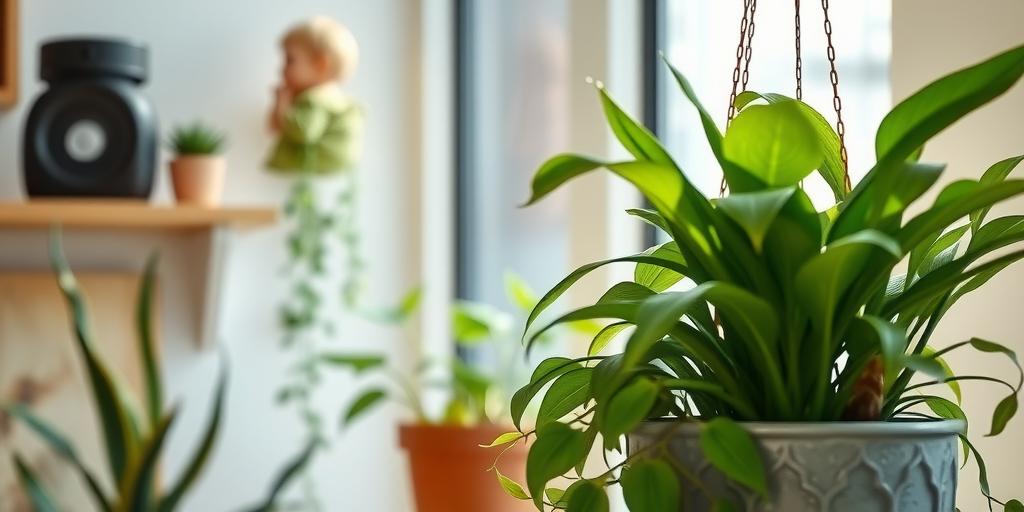
Safe Low Light Hanging Plants for Pets and Kids: Top Picks for 2025
Discover the best pet-safe and kid-friendly hanging plants for low light conditions! Our guide provides top plant picks, care tips, and essential safety advice to help you create a beautiful, worry-free indoor jungle. Find your perfect match today.
Introduction
Have you ever hesitated to bring a beautiful hanging plant into your home, worried it might be toxic to your curious cat or adventurous toddler? You’re not alone! As a plant lover and pet owner myself, I’ve faced that exact dilemma. The good news is that you absolutely can have a lush, green oasis that’s safe for everyone in the family. This guide is your one-stop resource for finding the perfect hanging plants that thrive in low light and pose no threat to your pets and kids. Let’s dive in and transform your space into a safe, verdant haven!
Key Considerations When Choosing Safe Hanging Plants
Before you start shopping, it’s essential to think through a few practical aspects that will help you choose the right plants and keep them—and your household—safe and happy.
Verify Toxicity with the ASPCA Database
This really is non-negotiable. Many common houseplants can be harmful or even deadly to pets and children if ingested. Don’t rely on hearsay or vague labels like “pet-friendly” without double-checking. The ASPCA maintains a comprehensive, searchable database of toxic and non-toxic plants. Before you bring any plant home, look it up. It only takes a minute and could save you a lot of worry—or worse, an emergency vet visit.
Assess Your Home’s Light Conditions
Light is everything to a plant. Take some time to observe the light in the room where you want to hang your plant. North-facing windows provide soft, indirect light that many low-light plants love. East-facing ones offer gentle morning sun, while south and west windows bring stronger, direct light that might be too harsh for some species. If your space doesn’t get much natural light, don’t worry—there are plenty of plants that thrive in those conditions. Just be honest with yourself about what you’re working with.
Choose Secure Hangers and Hooks
A falling pot isn’t just a mess—it’s a hazard. Make sure your hanging hardware is rated for the weight of your plant, especially once it’s watered. Ceiling hooks should be installed into studs or with appropriate drywall anchors. For heavier plants, consider a swivel hook that can support more weight. Always test the stability before hanging your plant, and check it periodically to make sure nothing has loosened over time.
Match Plant Care to Your Lifestyle
Be realistic about how much time and attention you can give your plants. Some require frequent watering, misting, or fertilizing, while others are perfectly happy with a little neglect. If you’re new to plant parenting or have a busy schedule, start with something forgiving. There’s no shame in choosing an easy-care plant—it’s better to have a thriving low-maintenance plant than a struggling high-needs one.
Consider Pot Material and Drainage
The right pot can make a big difference in your plant’s health. Terra cotta pots are porous and allow soil to dry out more quickly, which can help prevent overwatering. Plastic pots retain moisture longer, which might be better for plants that like consistently damp soil. Whatever you choose, make sure there are drainage holes. Sitting in water is a fast track to root rot, which is often fatal.
Our Top Picks: Pet and Kid-Safe Hanging Plants for Low Light
Now for the fun part—choosing your plants! Here are some of our favorite non-toxic, low-light tolerant options that look great hanging up.
Boston Fern
A true classic. Boston ferns are lush, full, and completely safe for pets and kids. They love humidity and indirect light, making them perfect for bathrooms or kitchens. Just keep the soil consistently moist (but not soggy) and mist the leaves occasionally to keep them happy.
Spider Plant
This is one resilient plant. Spider plants are not only non-toxic, but they’re also fantastic air purifiers. They produce lots of “pups” or baby plants that you can propagate and share. They tolerate low light well and can bounce back even if you forget to water them now and then.
Staghorn Fern
If you want something a little more unusual, consider a staghorn fern. These can be mounted on a board or hung in a basket, and their unique antler-like fronds make a real statement. They’re safe for pets and prefer bright, indirect light but can tolerate lower light levels too.
Peperomia
With so many varieties to choose from, there’s a peperomia for everyone. They come in all sorts of colors and textures—some have ripple-edged leaves, others are trailing, and some are more upright. All are non-toxic and relatively low-maintenance, preferring indirect light and moderate watering.
String of Hearts
This trailing succulent is gorgeous with its heart-shaped leaves and delicate vines. It’s safe for pets, though if you have a cat that loves to dig, you might want to hang it high just to be safe. It does well in bright, indirect light but can handle lower light too—just may not grow as quickly.
Ponytail Palm
Despite the name, it’s not a true palm—and it’s perfectly safe. Ponytail palms have a quirky, architectural look with a bulbous base and long, curly leaves. They’re extremely drought-tolerant and do well in indirect light, making them a great low-fuss option.
African Violet
For a pop of color, African violets are a wonderful choice. They bloom frequently even in lower light and are completely safe around pets. They prefer consistent moisture but don’t like wet leaves, so water from the bottom if possible.
Essential Care Tips for Thriving Low Light Plants
Once you’ve chosen your plants, giving them the right care will help them not just survive, but thrive.
Master the Watering Schedule
Overwatering is the number one cause of houseplant death. In lower light, plants use water more slowly, so they need less frequent watering. Always check the soil before watering—stick your finger about an inch down. If it’s dry, it’s time to water; if it’s still damp, wait. When you do water, do so thoroughly until water runs out the drainage holes, then empty the saucer.
Use the Right Soil and Pots
Well-draining soil is crucial. A standard potting mix amended with perlite or orchid bark can improve drainage. As mentioned earlier, always use pots with drainage holes. If you have a decorative pot without holes, use it as a cachepot—keep your plant in a plastic nursery pot inside the decorative one, and remove it to water.
Fertilize Thoughtfully
Plants in low light grow more slowly and need less fertilizer. During the growing season (spring and summer), you can fertilize every 4-6 weeks with a balanced, diluted fertilizer. In fall and winter, hold off entirely—plants are usually dormant and won’t benefit from extra nutrients.
Keep Leaves Clean
Dust on leaves can block light absorption, which is especially important in low-light conditions. Wipe leaves gently with a damp cloth every few weeks, or give small plants a lukewarm shower. Your plants will be able to photosynthesize more efficiently and stay healthier.
Recognize Signs of Distress
Yellow leaves often indicate overwatering or poor drainage. Leggy growth (long stems with few leaves) usually means the plant isn’t getting enough light. If you see these signs, adjust your care routine accordingly. Sometimes simply moving the plant to a slightly brighter spot can make a big difference.
Creating a Safe Environment for Pets and Plants to Coexist
With a little planning, you can enjoy your plants without constantly worrying about your pets or kids.
Hang Plants Strategically
Height is your friend. Hang plants high enough that curious paws and hands can’t reach them. For cats, remember they can jump, so go higher than you think you need to. Macramé hangers are great for this—they add style while keeping plants out of reach.
Use Deterrents
If your pet is particularly interested in your plants, try using a bitter spray on the pots and surrounding areas. These sprays are non-toxic but taste awful, which can discourage chewing. Always test a small area first to make sure it doesn’t damage the pot or leaves.
Provide Alternatives
Sometimes pets chew plants out of boredom or because they need more fiber. Offering safe alternatives like cat grass or catnip can divert their attention away from your decorative plants. It’s a win-win—they get a healthy snack, and your plants stay intact.
Choose Stable Planters
Heavy pots or wall-mounted planters are much harder to knock over. If you’re using a shelf, secure it to the wall if possible. For floor plants, choose wide, heavy bases that are less likely to tip.
Clean Up Fallen Debris Promptly
Fallen leaves or flowers can be tempting for pets to play with or eat. Get into the habit of checking around your plants regularly and sweeping up any debris. This not only keeps your pets safe but also helps prevent pests and mold.
Conclusion
Creating a home that is both stylishly green and completely safe for your family is not just a dream—it’s entirely achievable! By choosing from our list of non-toxic, low-light champions like the hardy Spider Plant or the elegant Boston Fern, and following our simple care and safety tips, you can cultivate your own indoor sanctuary with total peace of mind. So, what are you waiting for? Pick your favorite plant from our list, find that perfect spot, and start enjoying the benefits of a healthier, happier, and greener home today!
